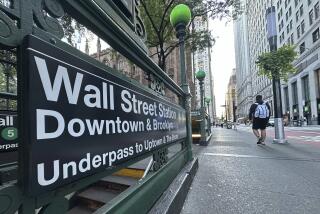Economic reports, central banks’ actions fuel huge stock rally
Reporting from New York — Dramatic efforts by central banks to pump more money into the global financial system are allowing investors to turn their attention back to more promising signals coming from the U.S. economy.
Investors turned exuberant Wednesday after a series of strong economic snapshots pointed to healthy job creation and more robust business activity in the nation. The strong data sent the Dow Jones industrial average to its best single-day performance since March 2009 and eased lingering concerns about the U.S. falling back into a recession.
Actions taken by the Federal Reserve and the European Central Bank to address the Eurozone crisis have for the moment lessened concerns about a financial system meltdown.
“A lot of what has been happening in the U.S. markets has been weighed down by the European situation,” said Paul Ashworth, chief U.S. economist with Capital Economics. “If it looks like we have a bit of relief from that, it’s not a surprise that people turn back to the U.S.”
The Dow closed up 490.05 points, or 4.2%, to 12,045.68 on Wednesday. Most broader indexes posted their biggest one-day gains since early August, when markets were bouncing wildly after Standard & Poor’s downgrade of the U.S. government’s credit rating.
Most of the market’s rise was credited to the moves by global central banks in the hours after the U.S. markets closed Tuesday.
Central bankers in China began late Tuesday by unveiling a plan that allowed the nation’s financial institutions to hold less money in reserve, freeing up more funds to stimulate economic growth. The step comes after a year of tightening monetary policy to rein in inflation and growing debt levels.
The cut suggests that Chinese policymakers are confident that inflation will taper off in the coming months. The nation’s inflation rate grew 5.5% in October from a year earlier, well below a three-year peak in July of 6.5%.
“Today’s surprise reserve ratio cut marks the start of an across-board easing policy for China,” wrote Qu Hongbin, an economist for HSBC.
Hours after the Chinese announcement, the Fed and five other central banks released their plan to make foreign transactions easier by lowering the cost of borrowing dollars. The move was greeted warmly because it represented a coordinated global action at a time when most of the planning has fallen to a few European countries.
“They were fighting the battle alone,” said Don Hays, the founder of Hays Advisory. “Today all the central banks of the world joined the team.”
But this is not the first time that a solution has appeared in sight for a European crisis that has dragged on for more than a year. Hays and other market watchers say that the program announced by central banks does not address the central problem in Europe, which is the tremendous debt levels in several countries on the continent.
“They’ve done nothing to stem the debt crisis yet,” said Steve Ricchiuto, chief economist at Mizuho Securities. “Why should we be jumping up and down for joy?”
The signs pointing to U.S. economic growth, on the other hand, are less likely to be a flash in the pan.
Over the course of November, 18 of 24 reports measuring economic output, employment and the housing sector were better than their previous readings, according to data firm Bespoke Investment Group. Most recently, investors were encouraged after a report showed that consumer confidence rose significantly in November, something that was also apparent in the increased spending over the Thanksgiving holiday weekend.
Investors also sifted through a strong report from payroll processor ADP that said private companies added 206,000 employees last month. That is almost 100,000 more than they added in October, and also nearly 100,000 more than analysts had expected.
An index of Chicago-area business activity ticked up in November, and the National Assn. of Retailers said the number of pending home sales rose more than expected in October.
Also, the Fed released its so-called beige book, which showed that economic activity “increased at a slow to moderate pace” in 11 of the country’s 12 districts.
Economists are waiting for Thursday’s monthly reading of a nationwide manufacturing index and Friday’s national employment numbers.
Strong reports from both well-watched reports could further help banish talk of the U.S. entering back into a recession — though developments in Europe are likely to remain the wild card.
“Things have certainly been a lot better than we could have hoped for a few months ago,” economist Ashworth said.
More to Read
Inside the business of entertainment
The Wide Shot brings you news, analysis and insights on everything from streaming wars to production — and what it all means for the future.
You may occasionally receive promotional content from the Los Angeles Times.










